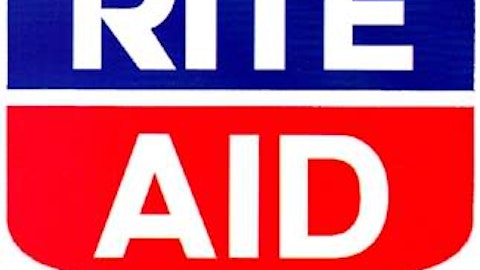Today, I’ll be looking at a favorite company of dividend growth investors: Wal-Mart Stores, Inc. (NYSE:WMT). This dividend champion has been increasing dividends for 39 consecutive years. This is an impressive streak, but this is just one of its appealing dividend fundamentals. Let’s check out the others.
10-year stock chart
The 10-year returns haven’t been that good as the average annual return was 4.5% (3.3% from capital gains and 1.2% from dividends).

The chart looks mostly flat until its recent spike. Wal-Mart Stores, Inc. (NYSE:WMT) looks to be a culprit of the lost decade.
Revenue and earnings
Wal-Mart has been making more and more money each year. This is exactly the kind of chart I like to see.

The same steady trend emerges when revenue per share and EPS are examined.

While Wal-Mart Stores, Inc. (NYSE:WMT) has very impressive revenue charts, the average annual growth rates are not quite where I’d want them. Typically I like to see growth rates above 8%, but revenue and net income are slightly below these levels.

While revenue and net income growth isn’t quite where I’d want it, the consistency of Wal-Mart’s earnings growth is superb.
Dividends
Wal-Mart Stores, Inc. (NYSE:WMT) is a dividend champion and has increased its dividend for 39 consecutive years in a row. Its most recent increase occurred with the dividend recorded in December 2012, when it increased the quarterly dividend by 18.2%.

Dividend growth
As you can see from the table below, Wal-Mart Stores, Inc. (NYSE:WMT) shows good average annual dividend growth rates.

With the most recent dividend increase of 18.2%, it looks like it plans on continuing high levels of dividend growth. Now, let’s see if the dividend is sustainable.
Dividend sustainability
The 10-year average annual dividend growth has been significantly higher than EPS growth, which suggests that eventually dividend growth should slow down.

Let’s take a look at the payout ratio to see how much room for growth the dividend still has.

The company has been increasing dividends faster than earnings, but because they have a reasonable payout ratio, the dividend is sustainable. The payout ratio has been steadily increasing and I expect this trend to continue for a while as there is still plenty of room for further increases.
Estimated future dividend growth
Analysts expect annual EPS growth to be 9.29% for the next five years. I think dividend growth will be slightly above these levels as this would be consistent with the past and the payout ratio is low enough to allow it. My guess is that annual dividend growth will be 10% to 15%.
Competitive advantage & return on equity (ROE)
I would consider Wal-Mart Stores, Inc. (NYSE:WMT) to have a wide moat over the competition and the ROE chart would support this as Wal-Mart has a consistently good ROE.

ROE is slightly above the industry average for department stores and about 6 percentage points higher than both Target Corporation (NYSE:TGT) and Costco Wholesale Corporation (NASDAQ:COST), which are major competitors.

Debt & liquidity
I want to invest in companies that are fiscally responsible, so it’s important to look at debt levels and see that they are at reasonable levels.

Fitch currently rates its debt at AA levels, and these ratios haven’t changed much over the past decade, so debt and liquidity levels are fine.
Shares outstanding
Shares outstanding have been steadily decreasing which is a good sign. I’d like to see this trend continue.

Valuation
Morningstar currently rates Wal-Mart Stores, Inc. (NYSE:WMT) as a 3-star stock as it’s currently priced around its estimated fair value of $74. For Morningstar to rate Wal-Mart as a 5-star undervalued stock, the price would have to fall below their “consider buy price” of $59.20.
I calculate my own target prices and came up with $64. To see the details of this calculation, read my full analysis of Wal-Mart.
Other investment options in the same industry
I found Costco Wholesale Corporation (NASDAQ:COST), Family Dollar Stores, Inc. (NYSE:FDO), and Target Corporation (NYSE:TGT) as strong dividend growth candidates in the same industry using the May 31, 2013, US Dividends Champions list.

Costco Wholesale Corporation (NASDAQ:COST) has the lowest payout ratio and highest estimated five-year average annual growth rates, but its dividend yield is well below my minimum entry yield of 2% to 2.5%. Its dividend growth rates in the past have been good and it looks like it’ll be able to continue strong dividend growth based on the low payout ratio and strong estimated five year annual growth of 13.4%.
Family Dollar Stores, Inc. (NYSE:FDO) is in a similar situation as Costco. It’s a good dividend growth stock, but the entry yield is too low for me right now. Family Dollar Stores has a more impressive dividend streak with 37 years of consecutive dividend increases versus Costco’s 10 years. Like Costco, I think Family Dollar Stores, Inc. (NYSE:FDO) will be able to continue strong dividend growth and its most recent increase of 23.81% would support this.
Target Corporation (NYSE:TGT) has the longest dividend streak and looks to have the best overall past dividend growth rate. With the recent 20% dividend increase, good estimated earnings growth of 11.6%, and a low payout ratio of 33.8%, it looks like this impressive dividend growth will continue.
Target’s current yield is just over 2%, so I would consider investing if it was reasonably cheap. Unfortunately, this is not the case right now. Morningstar currently has Target’s fair value as $58, and its five star “consider buy price” is $40.60. I will be staying on the sidelines for now as the current price is well above these levels.
In the table below you can see that all four companies are currently yielding close to their five-year average, which suggests that none of them are value priced.

When I look at these four companies, I get roughly the same conclusion for all of them. They all look like good dividend growth candidates, but none of them are undervalued which prevents me from investing.
Conclusion
Wal-Mart has a strong competitive advantage and a wide economic moat. It makes more and more money each year without fail and has strong dividend growth fundamentals. This is exactly the type of stock I’d love to invest in. I think dividend growth will be a little bit higher than earnings. At current prices, Wal-Mart Stores, Inc. (NYSE:WMT) is too rich for me, but if the price fell below my target price of $64, I would consider investing.
The article Wal-Mart Dividend Stock Analysis: A Buy at $64 originally appeared on Fool.com and is written by Michael Weber.
Michael Weber has no position in any stocks mentioned. The Motley Fool recommends Costco Wholesale. The Motley Fool owns shares of Costco Wholesale. Michael is a member of The Motley Fool Blog Network — entries represent the personal opinion of the blogger and are not formally edited.
Copyright © 1995 – 2013 The Motley Fool, LLC. All rights reserved. The Motley Fool has a disclosure policy.





